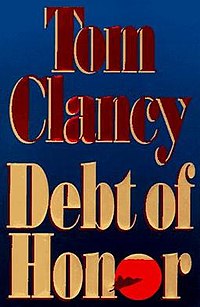Debt of Honor
by Tom Clancy
Japanese industrialist Raizo Yamata has been plotting to bring back his country to a position of greatness for years, partly as revenge for the death of his family at the hands of American forces invading the island of Saipan during World War II. His opportunity comes when a car accident in eastern Tennessee, caused by faulty gas tanks made in Japan, results in the deaths of six American people. The incident leads to the swift passage of a law allowing the U.S. to mirror trade practices of the countries from which it imports goods, cutting off the American export markets upon which the Japanese economy depends. Facing an economic crisis, Japan’s ruling zaibatsu, led by Yamata, decides to take economic and military action against the United States. Along with covert support from China and India, they plot to curtail the U.S. presence in the Pacific and re-establish the Japanese Prime Minister Mogataru Koga resigns in disgrace due to the economic situation, the zaibatsu installs Hiroshi Goto, an aggressive nationalist and critic of the U.S., to succeed him. Meanwhile, Japan has covertly developed nuclear weapons, and with SS-18 designs bought from the former Soviet Union, has fabricated and deployed several ICBMs.
Japan launches the first phase of its assault, sending Self-Defense Force units to occupy the Mariana Islands, specifically Saipan and Guam, without casualties. However, during a joint military exercise, Japanese ships "accidentally" launch torpedoes at the U.S. Pacific Fleet, destroying two submarines and crippling two aircraft carriers. An immediate retaliation is forestalled by the second phase of the Japanese offensive: an economic attack, where Japan engineers the collapse of the U.S. stock market by hiring a programmer who is a consultant for an exchange firm to insert a logic bomb into the system, which when triggered blocks the storage of all trade records made after noon on Friday. They also assassinate the chairman of the Federal Reserve. The Japanese government then immediately sue for peace, offering international talks and seemingly free elections in the Marianas to delay a U.S. response.
Meanwhile, Jack Ryan is pulled out of retirement from government service by U.S. President Roger Durling, who appoints him as National Security Advisor. Despite his typical focus on military issues, he advises the president to deal with the economic crisis first, realizing that Japan's deletion of trade records could be an advantage in responding to the economic threat. He engineers a "do-over", where all of the transactions that were deleted on the day of the mass deletion are ignored and all trade information is restored to its condition at noon of that day. The U.S. stock market is successfully restored with only minor disruption, and a group of U.S. investment banks start a massive economic unloading of Japanese investment products, effectively eliminating any gains made by the zaibatsu.
The United States military then proceeds to launch a counterattack on their Japanese counterparts using whatever resources they have. In a staged accident, CIA operatives John Clark and Domingo Chavez blind two incoming Japanese E-767 pilots with a Dazzler that causes them to crash upon landing. The U.S. Air Force then proceeds to eliminate the rest of Japan's AWACS system through low-profile military attacks using widely dispersed U.S. assets, allowing B-2 bombers to destroy the hidden ICBM silos. They later use an attack by stealthy F-22 fighters to further damage Japan's air defenses. An Army special operations team is airdropped into Japan to support covertly inserted Comanche helicopters. One helicopter is used to attack another AWACS plane with air-to-air missiles while several others use Hellfire missiles to kill members of Yamata's cabal. Meanwhile, Admiral Robby Jackson liberates the Marianas with few casualties by using a combination of cruise missiles and carrier air attacks to severely damage the Japanese aircraft stationed on the islands, which forces the Japanese commander to surrender his troops.
Outmaneuvered and cornered by the United States's military and economic response, Goto resigns, ceding power to his predecessor Koga, who was rescued earlier by Clark and Chavez from Yamata. Yamata and his surviving conspirators are arrested for treason, and the new Japanese government accepts the generous U.S. offer of status quo ante.
Throughout the book, President Durling faces another political crisis: Vice President Ed Kealty is forced to resign after being accused of rape. With the crisis over, President Durling nominates Ryan as vice president for successfully handling the crisis. However, an embittered Japan Air Lines pilot, driven mad by the deaths of his son and brother during the conflict, flies his Boeing 747 directly into the U.S. Capitol during a special joint session of Congress. The president, as well as nearly the entire Congress, the Supreme Court, and many other members of the federal government are killed in the attack. Ryan, who is on his way to be sworn as vice president after being confirmed, narrowly escapes the explosion. He becomes the President of the United States and takes his oath of office before a district judge in the CNN studios in Washington.
